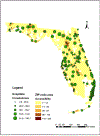Why Public Health Needs GIS: A Methodological Overview
- PMID: 32547679
- PMCID: PMC7297184
- DOI: 10.1080/19475683.2019.1702099
Why Public Health Needs GIS: A Methodological Overview
Abstract
The short paper provides an overview on how geographic issues have become increasingly relevant to public health research and policy, particularly through the lens of geographic information systems (GIS). It covers six themes with an emphasis on methodological issues. (1) Our health-related behavior varies across geographic settings, so should public health policy. (2) Facilities (supply) and patients (demand) in a health care market interact with each other across geopolitical borders, and measures of health care accessibility need to capture that. (3) Our health outcome is the result of joint effects of individual attributes and neighborhood characteristics, and an adequate definition of neighborhood is critical for assessing neighborhood effect. (4) Disease rates in areas of small population are unreliable, and one effective way to mitigate the problem is to construct a larger, internally-homogenous and comparable area unit. (5) Defining a scientific geographic unit for health care market is critical for researchers, practitioners, and policy makers to evaluate health care delivery, and GIS enables us to define the unit (e.g., primary care service areas, hospital service areas, and cancer service areas) automatically, efficiently and optimally. (6) Aside from various optimization objectives around "efficiency", it is as important to plan the location and allocation of health care resources toward maximum equality in health care access. Case studies are cited to illustrate each theme.
Keywords: GIS; health care accessibility; hospital service areas; location-allocation optimization; maximum equality; multilevel modeling; neighborhood effect; public health; regionalization methods; spatial heterogeneity.
Figures





References
-
- Blondel VD, Guillaume JL, Lambiotte R, and Lefebvre E 2008. Fast unfolding of communities in large networks. Journal of Statistical Mechanics: Theory and Experiment, 2008(10), P10008.
-
- Brazil N and Clark WAV. 2017. Individual mental health, life course events and dynamic neighbourhood change during the transition to adulthood. Health Place 45: 99–109. - PubMed
-
- Church RL 1999. Location modelling and GIS In Longley PA, Goodchild MF, Maguire DJ, and Rhind DW (ed.), Geographical Information Systems (2nd Ed) Vol. 1 NY: John Wiley & Sons; Pp.293–303.
-
- Cooper MM (1996). The Dartmouth Atlas of Health Care. Chicago, IL: American Hospital Publishing, pp. 2–26.
Grants and funding
LinkOut - more resources
Full Text Sources
